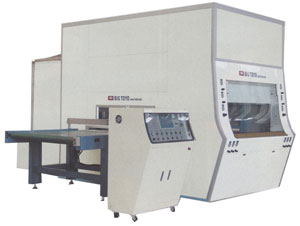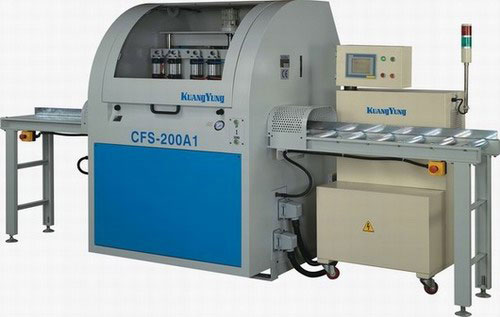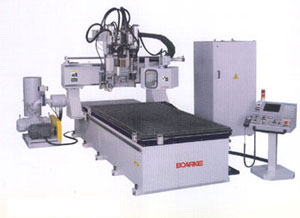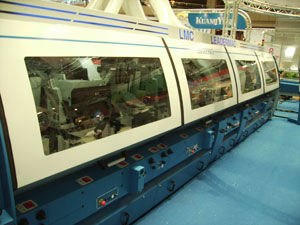Recession Necessitates Change Amid Taiwan's Woodworking Equipment Sector
2009/06/06 | By Ken LiuA positive side effect of the global recession is that Taiwan's woodworking-equipment makers have been motivated to brainstorm to upgrade as well as accept orders usually shunned by others: they are developing machines with features that help users cut cost, tapping core woodworking technologies to build non-woodworking machines, and eagerly vying small orders for made-to-order machines.
"Tougher economic times force wood product makers to be more cost conscious than ever, hence demanding equipment suppliers to offer machine tools that minimize manual operation and material waste, at the same time restricting raising prices," laments Bill Hung, chairman of the Taiwan Woodworking Machinery Association (TWMA).
As result, Taiwan's woodworking machinery makers have been prioritizing building equipment with higher degree of automation, speed and precision. The efforts have paid off: they have introduced machines boasting tolerance of plus and minus 0.01mm, precision that in the past was exclusive to CNC machines for processing metal.
The economic meltdown dragged the Taiwan woodworking equipment industry into losses in the second-half last year from gains in the first half, according to Hung. "Since the recession was global, no woodworking-equipment sector in any country was spared. I think our global performance in 2008 would not be worse than that in other countries although last year's results have yet been reported," Hung notes.
Years of improvement had catapulted Taiwan's woodworking-equipment industry into the world's No.4 place in 2007, trailing only Germany, Italy and the United States. The revenues generated was US$710 million that year, increasing 9.3% from a year earlier; and the woodworking equipment makers in Taiwan exported US$680 million in goods, making it the world's No.3 in 2007.

Automatic Painter
The recession has driven coating-equipment maker Big Toyo Machinery Co., Ltd. to look for greener pastures outside its own segment: its HAC1500 automatic painting machine being an efficient, eco-friendly example that can be used by non-woodworkers.
This unique, automated painter features cutting-edge designs as pressurized-air spray nozzles, air intake and exhaust, and reclamation system. Besides being able to handle oil and water-based paints, this machine has PLC controls operated via a touch-screen panel.
Precisely adjusted at 100 kilograms-per-square-centimeter in air pressure, the nozzles spray workpieces in perfectly even coats. "The pressure-per-square-area is configured after careful calculations," says company chairman Roger Fan, who has been in the industry for 28 years after graduating from the elite National Taipei Institute of Technology, now upgraded to the National Taipei University of Technology.

"The specific per-square-area pressure has been derived by testing-we found that higher pressure would cause overspray and lesser pressure would be inadequate," reports Fan. To ensure the precision of the pneumatic pressure, Fan adds an auxiliary one-kilogram-per-square-centimeter compressor to the nozzle.
HAC1500's precision, Fan boasts, saves 19% more lacquer relative to traditional machines from rivals.
The machine's reclamation system, Fan claims, achieves another 20% in conservation by channeling runoff from workpieces, filtered and then recycled. "Overall our machine can save nearly 40% of lacquer compared with traditional machines," Fan boasts.
The air intake draws in air through a filter into the closed spray chamber so the air exhaust, pushing at 0.6 meter per second, contains minimal dust that can contaminate workpieces, Fan says.
The HAC1500 coats workpieces at eight meters per minute, double the rate of its predecessor. "The key to the faster speed is its even spraying, which reduces the need to repeat spray workpieces," Fan says. The painter has unlimited length-wise capability, but can coat at maximum width of 1.5 meters and thickness of 50mm.
First in Taiwan
Fan claims he is the first Taiwanese woodworking-equipment supplier to build a patented pressurized-air painter, differing from traditional types using fan to spray lacquer onto workpieces.
The company introduced the HAC1500 last year and has shipped some 10 units mostly to wood-panel manufacturers.
In recent years, the company has begun supplying machines for coating housings for personal computers and mobile phones, as well as automobile dashboards. "Compared with woodworking equipment, machines for IT products pose higher entry barrier for the higher precision needed," Fan stresses.
Requested not to raise prices while bettering efficiency, the company, Fan says, can only increase the local-content rate and adjust manufacturing processes to pare down costs.
The global financial crisis, Fan thinks, could drive woodworkers worldwide to pursue less-expensive, automatic machines to reduce labor intensity and hence cost, increasing chances for Taiwanese equipment suppliers to win such orders. But he thinks equipment suppliers specializing in back-end machines like coating machines would be more likely to win the orders than front-end equipment suppliers specializing in cutting machines. "Taiwanese front-end woodworking equipment suppliers are world renowned for machines that carve patterns on solid wood. These machines are typically based on semi-manual designs since automation is impractical for complicated carving. In contrast, back-end equipment mostly handles simple processing, making it suitable for automation," Fan elaborates.
Precision Saw
For Kuang Yung Machinery Co., Ltd., the CFS-200A cut-off saw is a smart product that helps to buffer against the recession. This machine is ideal for cutting materials for finger-jointer production and mass production of woodworking parts.
The CFS-200A is multi-featured with precise cutting, high production efficiency, and energy conservation. Controlled by an optoelectronic sensor signaling the machine's computer which activates a servo motor, the saw cuts at precisely right lengths. "This control system helps save at least 5% more material than others," says Joe Chang, Kuang Yung's general manager.
In addition, this machine is three to five times more efficient than manual cut-off saws. With multiple saw blades, this machine cuts a two-meter-long stock into 10 pieces in only eight seconds and a four-meter-long stock into 10 pieces in only 10 seconds.
The CFS-200A has a maximum feed speed of 150 meters per minute and maximum 180 cuts per minute, with a maximum cutting size of 75mm (height) x 135mm (width) or 38mm (height) x 200mm (width).
Being numerically controlled via an industrial computer powered by a 32-bit floating-point digital signal processing (DSP) system, the saw is much more versatile than ones driven by PCs, achieving fail-proof operation under high ambient temperature, unstable voltage, and sawdust contamination. All commands are enabled via graphics on a screen, making it global-user friendly. "This machine is mid-range priced," Chang stresses.
Another smart saw from Kuang Yung is a rip saw with movable blades controlled by a computer wired to a sensor that locates optimal cutting distance. "This control system saves users quite a lot of time compared with traditional types, which must be manually adjusted for cutting length between blades," Chang says. His company will debut this machine in May at a trade show in Germany.
According to Chang, Kuang Yung has many advantages over its rivals: "We have a broad market, diversified products, set up good relationship with sales agents worldwide, and gained buyers' trust with good quality."
Two Experts
The company's competitiveness is further sharpened by two partners: a British mechanical designer and a Taiwanese electromechanical expert. "I would say domestic rivals can hardly keep up with our electromechanical expert's designs," Chang says. And the British ally, Chang stresses, is a mechanical expert who effectively combines book-smart with street-smart and cost considerations. "His designs are usually feasible although he has no factory," Chang says, adding that the expert has been in the machinery industry for over 30 years.
Backed by such advantages, the company introduces at least one new machine and five design upgrades a year. So far, the company has won at least five patents on its designs.
Also, Chang hopes his company can weather the economic downturn with its considerable expertise, despite the "unprecedented and the worst financial disaster" he has ever seen. However, Chang thinks the crisis has hit the island's woodworking-equipment industry less seriously than the machine-tool industry. "I see the woodworking-equipment sector as much more nimble than its machine-tool counterpart thanks to our much smaller operation scale, more diversified product lines," Chang comments. He notes also that having built sizable material inventory exposes machine-tool manufacturers to higher risk.
Small Orders
The recession, Chang analyzes, has ruthlessly put the writing on the wall: forcing the island's woodworking-equipment manufacturers to increasingly vie for small orders for highly customized machines. "When the times were good, domestic manufacturers were busy competing for big orders for mainstream machines, gearing their capacities only for these orders. Now the big orders are gone, so they turn to pursuing small buyers," he says. He thinks the recession will push Taiwan's woodworking-equipment industry to move quickly toward customized production. "This is becoming our niche and those who neglect this sector will soon lose competitiveness," he comments.
Mainstream orders, he says, have gone to mainland China, which has long copied Taiwan's machines as a way into the industry. But copycatting and shoddy quality, Chang says, have cost the mainland's equipment manufactures dearly: Many buyers have returned to Taiwanese suppliers for quality machines-a hard lesson learnt-for you get what you pay for.
Also manufacturers in mainland China have lost some of their cost advantage, due to rising labor costs and the surging yuan against the greenback. "Most of all, Taiwanese equipment suppliers are very willing to work with customers to reduce costs and develop built-to-order machines," he says.
Chang emphasizes that the United States and Europe are the markets especially for front-end equipment for cutting panels. "Building-materials and wood products manufacturers in the United States and Europe are our targets for rip saws and cut-off saws," Chang says.

CNC Machining Center
One of Boarke Machine Co., Ltd.'s notable machines is a moving-bridge type CNC machining center. This machine comes with one spindle and one tool magazine coupled with seven vertical and two horizontal lines of boring heads. Its drum type tool changer needs only eight seconds to change a cutter, with a tool magazine holding as many as eight tools.
This smart machine has a double-guide way and double-side driving structure, making it a very efficient model. Its vacuum working table is divided into two work zones, with one zone machining while the other feeding materials simultaneously. Its servo motors are made in Japan and its spindles come from Italy.
Special design allows the machine to directly cut boards without pre-sawing it into smaller pieces, eliminating the need to install molds for sawing. This machining center is ideal for sophisticated woodworking-handling diversified pieces in small volume like cabinet doors, solid-wood doors, computer desks and panel-type furniture. Also, this machine can process plastic and soft-metal workpieces.
"The machine's high processing precision eliminates reprocessing," says TWMA's Hung, who is also Boarke's chairman. The machine ensures minimal processing error of only plus and minus 0.00002mm thanks to computerized control, which uses Window-based program. "When a machine mass produces knock-down parts, you need to upgrade their precision so the parts perfectly fit each other," he explains.
This machine's spindle moves on five axes, with one axis horizontally turning 360 degrees and another vertically turning 360 degrees.
Security and user-friendliness are the major selling points: Infrared sensors are installed around the worktable, shutting down the machine when people are detected entering the work area. Also, its control computer has email capability, saving operator the trouble of leaving the machine to handle emails.
10-Spindled Molder
The Leadermac Machinery Co., Ltd. is promoting two cutting-edge machines-the LMC 1023T four-sided molder and a smart tool change system for CNC machines. The molder is numerically controlled and has four to 10 spindles in diameters of 1 13/16 inch, 50mm and 2 1/8 inch, which turn at 6,000, 7,200 and 8,000 rpm.
The molder processes widths of nine, 12 and 13 inches as well as thicknesses of six and eight inches.
This machine has an average 150 meter-per-minute processing rate, nearly four times that of generic types. "Such output is now only achieved by Leadermac's molders and German molders," claims Michael Chang, the company's CEO. Also, this machine features tolerance of only plus and minus 0.02mm in response to rising demand from DIY-furniture buyers for higher precision, according to Chang.
This machine is controlled by Windows-based PLC program and comes with operating manuals in seven languages. The machine mostly goes to Europe and the United States, where labor costs are relatively higher. It is ideal for making wooden furniture, flooring, kitchen furniture, and building materials.
The company's efficient tool change system boasts tool calibration time of only five minutes, compared with reported 30 minutes in systems from others. The system can control a maximum of six machines at once. "We developed the system in cooperation with dedicated software and hardware companies," Chang says.

Jointer Feeder
Co-Matic Machinery Co., Ltd. is proud of its patented AF114 jointer feeder, which stresses safety and efficiency.
This machine has a single segmented roller design instead of the track type, the usual component in most jointer feeders. Compared with track-type feeders, the company's roller-type feeder ensures tighter feeding with multi-studs per segment, each with independent suspension. "The stud and suspension design ensure workpieces are firmly 'pressed' on feeding belt, avoiding edges of the pieces from flapping," a Co-Matic sales representative says.
The unique design allows this machine to feed continually one piece after another or feed multiple pieces at once. The safety guard is a key feature, preventing users from reaching the cutters. "This machine is light, small, and economical," the sales representative stresses. (March 2009)




